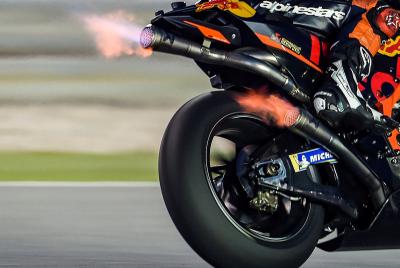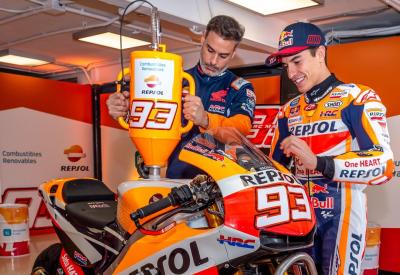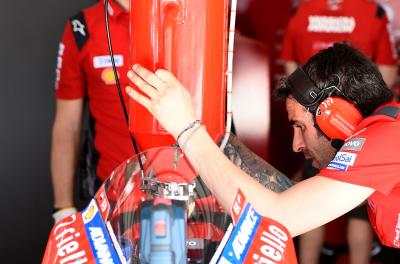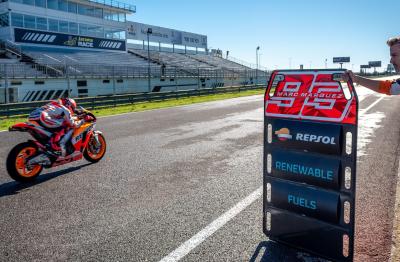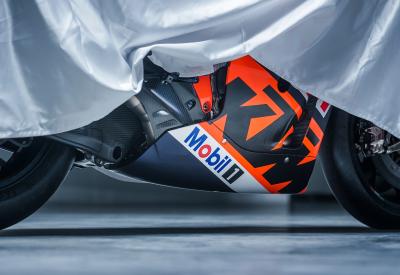Explained: eFuels, Biofuels and MotoGP 2024 - Exclusive
40 per cent of the fuel used in MotoGP next season will need to be of non-fossil origin, rising to 100 per cent from 2027.
The first 2024 prototypes, running on the new fuel, are expected to be seen in public at September’s Misano test.
Crash.net spoke to MotoGP’s Director of Technology, Corrado Cecchinello, about the key differences between the different types of non-fossil fuels available, eFuel and Biofuel, what the change might mean for track performance and engine design, and more...
- MotoGP aerodynamics: Ride-height as ‘DRS’, moveable fairings in future?
- Front ride-height ban ‘correct thing to do’ - rear next?
- ‘Danger zone’: MotoGP’s new accident detection system explained
Corrado, ‘40% non-fossil fuel’ will be used in MotoGP from next season, what exactly does that mean?
Corrado Cecchinelli:
The regulation we are introducing in 2024 says that 40% of the fuel shall be of non-fossil origin and this is prescribed in terms of the proportion of C-14 [Carbon 14] over C [Carbon].
C-14 is ‘young carbon’, meaning carbon that has not been produced over millions of years, as in the case of carbon present in fossil fuels. So if you measure the amount of young carbon in a fuel over the total percentage of carbon, that must be 40% or over.
This is the way we define our 40% fuel. It’s just one practical definition.
So fossil fuels don’t contain C-14?
Corrado Cecchinelli:
Correct.
Actually, measuring C-14 is also the way they date things like dinosaur bones. The amount of young carbon decays with time, so this tells you how old something organic is (very old if no C-14).
EFuel or Biofuel?
Are there many potential sources for the future MotoGP fuel?
Corrado Cecchinelli:
Yes, for example, some people use the phrase ‘eFuel’ as a general term for any non-fossil fuel, but this is not correct. ‘eFuel’ means synthetic fuel, because the ‘e’ stands for electricity, so it describes how the fuel is produced.
eFuel is one method to create the 40% non-fossil fuel. But another way is by using Biofuel.
If we want to go deeper into the chemistry, when you use Biofuels, the carbon you are introducing is all ‘young carbon’, as it comes from vegetables or biomasses and not crude oil.
But if you use eFuel, so synthetic fuel, you are basically ‘catching’ carbon from somewhere - from the air, for instance - and using it. So it is not a given that you are catching only young carbon.
So in a regulation that prescribes a specific amount, a percentage of C-14, Biofuels are to me an easier and safer way to match the prescriptions, whereas I think it's more difficult to make the non-fossil fuel in a laboratory (eFuel) because in general you don't know where the carbon you are using originally comes from, so you will have to take care of it.
In the case of an eFuel, when you test the end product, it might not have the amount of young carbon you were expecting?
Corrado Cecchinelli:
Yes. It may be the case that your eFuel doesn't come from oil refinement, which is fine in principle, but the end product still contains less than 40% ‘young carbon’.
This is perhaps because the carbon you used came from the atmosphere and you never know where the atmospheric carbon comes from.
Because eFuels are basically catching free carbon from somewhere, the atmosphere in general, and ‘squeezing’ it together with hydrogen, you don't know the origin; this is their true concept which is compromised when you have to source bespoke young carbon.
So even if it is true that you are not using oil as the starting base, it might still give a measurement of less than 40% young carbon.
So it’s harder to control the young carbon output for eFuel?
Corrado Cecchinelli:
Yes: you have to be careful with the carbon sources to achieve the goal. So probably the next step for us will be based on certification of the production.
I mean, if you can prove that your fuel is 100% synthetic, made entirely in a laboratory, for me it’s 100% non-fossil even if when it’s measured, I found 80% ‘fossil (old) carbon’ because you still did something good for the atmosphere.
The idea behind eFuels is that they are claimed as carbon neutral because you remove from the atmosphere the same amount of carbon that you are later releasing in engine combustion.
But, to create eFuel you also need a lot of [electrical] energy, the ‘e’.
Ideally, the electricity used needs to come from a renewable source like solar panels?
Corrado Cecchinelli:
If it’s from solar panels, then the eFuel is actually carbon neutral. But if you make it with electricity from a coal-fired power plant, then you are just releasing additional carbon, not by combustion [on the bike], but when you produce the eFuel; this may still be acceptable in racing, but it would not make this a “sustainable” fuel when used for road transportation on a large scale.
So I'm expecting, but this is just me, the next step will be in 2027, when all 100% of the fuel must be non-fossil, that we'll have to consider something like:
‘You can use whatever method you like - synthetic eFuel or Biofuel - as long as you prove that no fossil origin energy is used in the whole creation process’.
Because if you are making a non-fossil fuel by biomass, in principle, you don't need a lot of energy. So as long as you can prove your fuel comes from waste, this is not fossil fuel.
But in the case of eFuels there's a lot of energy involved in the production, so you have to prove where it comes from.
All the relevant players will be involved to come up with the best and most sensible prescriptions possible, to provide the best road-relevant alternative possible to electric mobility.
We should also keep in mind that the ultimate goal of MotoGP is not minimising the event carbon footprint, which is of course good in itself, but pioneering viable technologies for the world.
So it can even be the case that proving bio or synth origins of the racing fuels will be considered enough without the complication of energy source certification in racing, on the assumption that the big road transportation quantities will be produced by only using sustainable energy. This is not that important for the dismal quantity of fuel that the bikes use in a MotoGP race, when compared to the whole world of transportation.
What I mean is that even just proving it is possible to achieve the desired level of performance with fuels that have no fossil origin is to me enough of a statement!
Do you think anyone will choose eFuel? It sounds like it's more complicated than Biofuel…
Corrado Cecchinelli:
I think it’s not the easiest way to comply with the 2024 regulations because of the reasons I’ve given you. But I think that if in 2027 we add these additional prescriptions to the specification, it's viable. It all depends on the proprietary know-how and confidence of any specific fuel supplier.
Because Biofuels also have problems since they can use up sources of food, such as corn and beetroot.
So then there are ‘second-generation’ or ‘advanced’ Biofuels, which are created without using sources of food. These are based on things like waste or a kind of bespoke algae or vegetables. So you're not subtracting food from the system.
There are issues with both Biofuels and eFuels when you care about sources on a scale that is larger than just racing: Biofuels are trying to use the same sources humans might use for food and synthetic fuels need a lot of energy. Races themselves, as said, of course have basically zero impact on this.
It's very easy to produce hugely expensive eFuel but if you want to have a reasonable price and use clean energy it’s a completely different matter.
Could the new fuel lower bike performance? “It's a way to strike both goals”
Performance-wise, will there be much difference between using eFuel/Biofuel and the current fossil fuel?
Corrado Cecchinelli:
At 40%, I would expect no difference. At 100%, I would expect some difference.
There are also probably chemical aggression issues - maybe you have to change seals and everything. But this is not relevant to your question.
I would expect an initial drop in performance at 100% simply because at present the non-fossil fuels are ‘lighter’ than the regular fuel today, meaning the energy density is lower.
That means having the same amount of energy available would still be possible, but maybe you would need to use 30 litres of fuel per race instead of the current limit of 22 litres.
But we are considering introducing the 100% non-fossil fuel [in 2027] plus a reduction, not an increase, in the fuel tank capacity. So in this sense, I would expect a drop in performance. But only because there is a limit on the amount of fuel.
If you were going to say, ‘This is the energy today and we want to allow the same energy tomorrow [using non-fossil fuel] by increasing the fuel tank capacity’, then you would have no drop in performance, or minimal.
So the drop in performance is just a matter of not adjusting the fuel tank capacity to compensate for the change in density. But the fuel manufacturers are sure to make steps to regain that performance over the following years, maybe even before the introduction.
So the new fuel could be a useful way to lower the performance of the bikes?
Corrado Cecchinelli:
When we talk about sustainability, one thing is environmental issues, but another thing is reasonable performance. By reasonable, we mean not excessive. So for us, it's a way to strike both goals.
We can’t say now whether 100% sustainable fuels will be a roof or a reduction for performance in 2027, but for sure they won’t help with going faster.
And without needing to totally redesign the engines?
Corrado Cecchinelli:
Probably with 100% non-fossil fuel they will have to consider some design features. I'm not working from the engine design point of view, but I would consider that the ideal compression ratio or engine breathing capacity is not the same.
Maybe you need a different ignition timing, and possibly a different shape of the combustion chamber. All these kinds of things. But this is a worthy side project because it is also road relevant, and it’s not an extra cost when properly planned, as racing engines wouldn’t stay the same anyway.
Is it possible that the 100% non-fossil fuel could be introduced before 2027?
Corrado Cecchinelli:
It’s a possibility, but we are not pushing for it. We would welcome a proposal to make it earlier from the manufacturers, but for us, it's not a matter on the table. For us, it’s 2027.
Because in the end, it’s the manufacturers that have to do the work for this change. So it’s not fair for us to say ‘OK, before we said ’27, now it’s ‘25!’
But there is a chance the manufacturers will all agree and want to anticipate the change to non-fossil fuel early because I think they are all involved in this work in their daily [road bike] activities.
We are all doing our best to keep regulations consistent up to and including 2026. But still all the manufacturers have happily agreed on the 2024 fuel change, as they believe it is beneficial in many respects and worth introducing before the [five-year] stability term ends.
So why not, this may happen again, but not because we are pushing for it.
